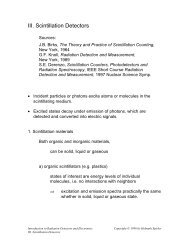Introduction to radiation-resistant semiconductor devices and circuits
Introduction to radiation-resistant semiconductor devices and circuits
Introduction to radiation-resistant semiconductor devices and circuits
You also want an ePaper? Increase the reach of your titles
YUMPU automatically turns print PDFs into web optimized ePapers that Google loves.
Metal-Oxide Silicon Field Effect Transis<strong>to</strong>rs (MOSFETs)<br />
Within the FET family, MOSFETs present the most pronounced ionization<br />
effects, as the key <strong>to</strong> their operation lies in the oxide that couples the gate <strong>to</strong> the<br />
channel. As described above <strong>and</strong> illustrated in Fig. 2, positive charge buildup due<br />
<strong>to</strong> hole trapping in the oxide <strong>and</strong> at the interface shifts the gate voltage required for<br />
a given operating point <strong>to</strong> more negative values. This shift affects the operating<br />
points in analog circuitry <strong>and</strong> switching times in digital circuitry. Reducing the<br />
thickness of the gate oxide <strong>to</strong>x greatly improves the <strong>radiation</strong> resistance; gate<br />
voltage shifts scaling with <strong>to</strong>x 2 <strong>to</strong> <strong>to</strong>x 3 for a given dose have been observed. (6)<br />
Thinner gate oxides are required for small channel lengths, so higher density processes<br />
tend <strong>to</strong> improve the <strong>radiation</strong> resistance even without special hardening<br />
techniques. The gate voltage shift is typically expressed in terms of threshold<br />
voltage VT, which roughly marks the onset of appreciable current flow.<br />
Typical threshold shifts for a 1.2 μm <strong>radiation</strong>-hardened CMOS IC process<br />
with a 20 nm thick gate oxide are shown in Fig. 6. (36) After exposure <strong>to</strong><br />
5 Mrad(Si) of 60 Co ir<strong>radiation</strong>, NMOS thresholds shift by 200 mV <strong>and</strong> PMOS<br />
levels change by 150 mV. For both NMOS <strong>and</strong> PMOS <strong>devices</strong> the threshold<br />
voltage shifts <strong>to</strong> more negative values as expected from positive charge buildup in<br />
the oxide. The slight upturn above 2 Mrad in the NMOS curve is typical <strong>and</strong><br />
reflects the buildup of interface states. (6) About 70% of the threshold shifts occur<br />
during the first 250 krad, also a typical phenomenon. Measurements <strong>to</strong> 125 Mrad<br />
on a similar process show a <strong>to</strong>tal threshold shift of 400 mV for NMOS <strong>and</strong> 100<br />
mV for PMOS with little increase beyond 10 Mrad. (37)<br />
THRESHOLD [V]<br />
0.8<br />
0.7<br />
0.6<br />
0 1 2 3 4 5<br />
DOSE [Mrad]<br />
-0.8<br />
NMOS PMOS<br />
THRESHOLD [V]<br />
-0.9<br />
-1.0<br />
16<br />
0 1 2 3 4 5<br />
DOSE [Mrad]<br />
FIGURE 6. Threshold voltage shifts for <strong>radiation</strong>-hardened NMOS <strong>and</strong> PMOS<br />
transis<strong>to</strong>rs vs. 60 Co <strong>radiation</strong> dose.





